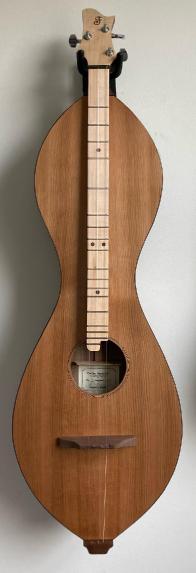New Professional Model Overview
I wanted to post this overview first and foremost to give members of this site ideas and potentially inspire builders to try new designs as I was inspired by many on and off this site. This design is the culmination of a little over three years of trial, error, prototypes and research. My goal was to create an instrument that could be played professionally in venues where a very loud instrument was required, while maintaining the fundamental sound of a dulcimer. There are several major design features that make this instrument fulfil those requirements.
1. A partial fretboard that is tied to the bracing and only touches the fretboard in one location.
2. A soundboard bracing pattern that maintains a traditional dulcimer frequency response and is balanced and not bass heavy.
3. An angled fretboard that puts more pressure on the top, driving the soundboard and increasing projection.
4. Very thin back and sides that increase the prominence of the back and sides in sound production creating a woodier, more "dulcimer" like tone.
The angled fretboard is an important feature of this design, as it drives the top to make this dulcimer about twice as loud as a traditional dulcimer design.

As you can see there is a 1.5 degree angle to the fretboard to increase the break angle on the bridge. This is roughly the same angle as a flattop mandolin. It is small enough that it is not noticeable while playing. The support is located in the center of the waist for strength and to tie into the upper-bout latter brace. In addition, the fretboard and headstock are a lamination of walnut-maple-walnut much like how some people laminate necks of guitars.
The bracing system I use is the culmination of a lot of prototypes and is a hybrid x-brace and latter brace arrangement. The braces are voiced to create a higher frequency spectrum to maintain a traditional dulcimer sound that is louder and more focused. This bracing and voicing method allows me to make sure this dulcimer doesn't sound like a three-string guitar. I have started to thickness WRC tops to about 2.5mm and have had very good results.

This is just the bracing pattern that I have found is the best balance between sound and rigidity so far, I'm sure this pattern will change as I further the design. In addition, the back has a full ladder brace and backstrap and is about 2mm thick walnut.
The instrument has binding as well as headstock, fingerboard, and rosette inlays that can be seen in the pictures posted on my homepage for the site. If you are interested in listening to the result, a sound sample can be found in the same place.
I hope this helps builders who are experimenting with designs to push the envelope of what dulcimers can do. I plan to build these custom, but if you are interested in this one, you can message me or email me at frederickinstruments@gmail.com.

